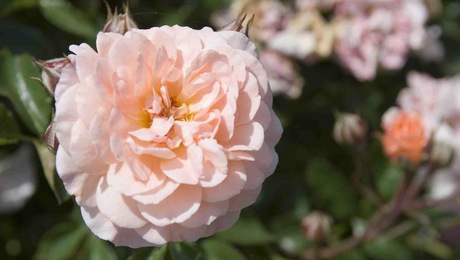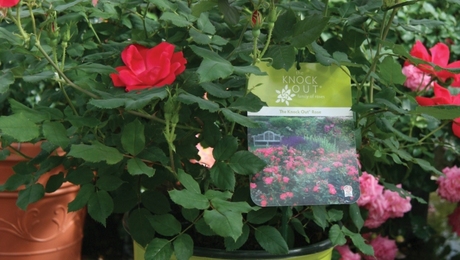
Photo/Illustration: courtesy Conard Pyle

Photo/Illustration: courtesy Conard Pyle
The demand from the public for healthier roses has led to changes in the ways roses are tested well before they are chosen to be made available for sale to gardeners. A comparison of the newer techniques to the older ones also illustrates the rose breeding and growing industry is taking strong actions to make sure the garden roses you buy are not the Garden Diva roses of yesteryear.
For a number of years roses in the test fields were actually sprayed with fungicides. Not overwhelmingly but they were certainly not allowed to fight off disease on their own under no spray conditions. Additionally the roses were budded, something as we’ve discussed before pushes roses along with almost an “artificial vigor”. So while perhaps the roses were not as coddled as they were in some backyards they did receive chemical treatment for disease.
This was not totally the industry’s fault. The obsession in the United States was with the long stem hybrid tea and disease resistance was way down on the list under flower, form and stem length. The industry was simply reacting to public demand.
However, a few major rose companies began to break with the old methods of testing and began thinking health and beauty were not mutually exclusive. In Europe one of the first was the German rose nursery W. Kordes’ Söhne – generally simply called Kordes.
When the fourth generation owner William Kordes III took over the family nursery in 1990 one of his first steps was to stop spraying the fields. The initial results were not good as rose after rose defoliated when their chemical treatment was taken away. Those roses that did remain healthy was put into the breeding program, crossed with other healthy roses and over time the entire rose line became healthier.
In the United States the firm of Conard-Pyle also began to raise the importance of health in the roses they tested and offered. Current CEO Steve Hutton notes two essential differences in the way Conard-Pyle now tests roses verses the past.
First, as with Kordes, they stopped spraying their test fields. Completely. While in years past they did some light spraying currently they do not spray at all.
The second difference is they used to test all their roses as budded plants. As we’ve discussed before understocks on budded plants are chosen to push a rose along regardless of its own natural vigor – or lack of it. To discover those roses that were not only naturally disease resistant Conard Pyle also made the decision to test all their roses as own-root roses. As we discussed in “Why do some roses do own-root and some don’t” an own-root rose will only be as inherently healthy and vigorous as the variety itself. There is no rootstock to push it along. Therefore a rose tested on its own-roots that turns out to be naturally vigorous and inherently healthy is truly a Garden Rose!
Testing roses only on their own-roots is yet another step towards the rose nursery industry leading the search disease resistant, naturally vigorous roses. It’s a credit to Conard-Pyle and other rose nurseries they are implementing new testing techniques to further illustrate there is a difference between today’s garden roses and they Diva roses many gardner grew up with. And that difference now starts long before the rose ever arrives at your garden center.
Fine Gardening Recommended Products

Berry & Bird Rabbiting Spade, Trenching Shovel
Fine Gardening receives a commission for items purchased through links on this site, including Amazon Associates and other affiliate advertising programs.

Ashman Garden Cultivator (1Pack)
Fine Gardening receives a commission for items purchased through links on this site, including Amazon Associates and other affiliate advertising programs.

A.M. Leonard Deluxe Soil Knife & Leather Sheath Combo
Fine Gardening receives a commission for items purchased through links on this site, including Amazon Associates and other affiliate advertising programs.


















Comments
Excellent article Paul. Great information indeed!
Stan The Roseman :o)
Thanks!
Log in or create an account to post a comment.
Sign up Log in